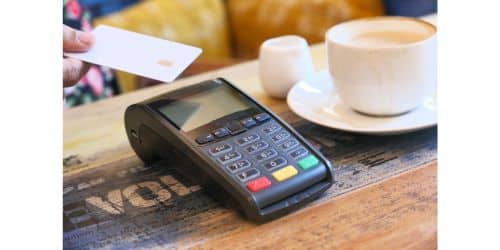You need a POS system to take payments and conduct in-person sales whether you want to start a brick-and-mortar business, pop-up shop, sell at events or sell from the trunk of your vehicle. Finding the ideal POS system, however, might be challenging, particularly if your company began online and you are considering trying out in-person sales for the first time. To assist, we created this straightforward guide. Keep reading on to learn everything about a point-of-sale software system for a restaurant so you can choose the best system for your small business and simplify managing your retail operations.
What is a Point of Sale Software?
A POS system, also known as point-of-sale software, streamlines retail sales transactions. A cash register is a well-known example of a POS system. A barcode scanner, card reader, cash drawer, and receipt printer are common components of modern POS systems, which are a combination of hardware and software. A touchscreen is frequently used as the user interface. The simplest point-of-sale (POS) system nowadays is a tablet attached to a credit card scanner.
A firm used to be able to ring up customers and receive payments using just a cash register. However, modern firms also require a mechanism to accept payments, monitor sales, control inventory, and produce reports. All of it may be taken care of by the appropriate POS system.
How Does a Point of Sale Software Work?
Customers are guided by a point-of-sale software system through a series of processes that result in a successful purchase. It typically operates in the manner described below:
- A customer decides which item(s) to purchase. To complete their payment, the customer either physically presents the items at the checkout kiosk at the store or views their digital shopping cart.
- The item(s) are priced by the POS system. The POS system for the company totals the price of the customer’s purchase, including any necessary tips and sales taxes. POS software that offers discount management options is frequently used by organizations. These enable businesses to monitor how customers use coupons and promotional codes.
- The client pays. Customers often use credit cards, cash, or checks to make payments. As a result, hardware like cash drawers, card or check readers, and receipt printers are frequently included with POS systems. While there is no requirement for physical components in online retailers, their point-of-sale systems frequently have plugins or apps that enable customers to pay using credit cards, PayPal, or even digital currencies like Bitcoin.
- The transaction concluded via the POS system. The computer program does calculations to ascertain how much the consumer owes and any specific change that could be necessary. Any remaining change is now manually returned by a cashier or the automated machine itself. Online buyers are sent to a post-purchase page that contains the necessary purchase and shipment information. Customers typically get a confirmation email.
Point-of-Sale Software Types
There are many different kinds of POS systems available, ranging from straightforward card readers to all-in-one options. Your particular demands will determine which point-of-sale system is appropriate for your small business. Here is a list of the various sorts you might come across:
#1. Restaurant POS.
A particular kind of POS system created specifically for restaurants is called restaurant point of sale software. These systems frequently have features like online ordering, kitchen display systems, and table management. Most will also include inventory control, allowing you to automatically restock items when they run out. Even POS systems exist that have capabilities perfect for running bars.
#2. Retail POS.
A retail POS system is made specifically for retail establishments. These systems frequently have components like gift cards, customer loyalty programs, and inventory management. A few retail point-of-sale systems additionally provide reporting and appointment booking.
#3. iPad POS.
An iPad serves as the primary point-of-sale terminal in an iPad POS system, a form of mobile POS system. Due to their portability and simplicity of use, these systems are becoming more and more popular. Numerous iPad point-of-sale systems provide built-in functions like credit card processing, scheduling, and receipt printing.
#4. Mobile POS.
One kind of POS system that may be utilized on a mobile device, like a smartphone or tablet, is a mobile POS system. Because they are portable and simple to set up, people are depending increasingly on these systems. Many portable point-of-sale systems have built-in capabilities like credit card processing, inventory control, and receipt printing.
#5. Android POS.
A type of mobile point-of-sale system known as an Android POS system makes use of an Android device as the primary point-of-sale terminal. These systems are also becoming more and more popular because of their portability and user-friendly interface. The majority of Android POS systems include functionality like receipt printing, barcode scanning, and credit card processing.
#6. Cloud POS.
A POS system that is hosted in the cloud is known as a cloud POS system. This indicates that all of your information is kept online and is accessible from anywhere. Because they are more convenient to set up and operate than conventional POS systems, cloud POS systems are growing in popularity.
#7. POS Terminal.
For organizations that need to accept credit and debit cards, a POS terminal is a form of POS system. These terminals often have functions like fraud prevention, EMV compliance, and PCI compliance.
Which Pos System Features Are The Most Important For Your Business?
The correct POS features will simplify and streamline your business’s operations. These are some characteristics of retail point-of-sale software you should look for.
- Payment Processing
- Inventory Management
- Customer Management
- Loyalty Programs
- Employee Management
- Reporting
- Add-ons and Integrations
- Customer Support
Benefits of a Retail Point of Sale Software
By automating the transaction process and keeping track of crucial sales information, electronic POS software systems enhance retail operations. An electronic cash register and software to coordinate data gathered from everyday purchases are included in basic systems. Installing a network of data-capture devices, such as card readers and barcode scanners, can allow retailers to expand functionality.
Retailers can monitor price accuracy, inventory fluctuations, gross revenue, and sales patterns depending on the program’s capabilities. Also, retailers can detect inconsistencies in pricing or cash flow that could result in profit loss or disrupt sales by using integrated technology to track data. Retailers can minimize problems with customer service, such as out-of-stock sales, by using POS systems that track inventory and purchase patterns. They can also better target their marketing and purchasing to match client behavior.
Small Business Point of Sale Software
The finest point-of-sale software for a small business does other tasks in addition to handling transactions. By merging elements like employee scheduling, customer loyalty programs, and inventory management into one slick platform, these technologies may also expedite your everyday routine. Picking the ideal system can indeed be difficult. To compile this list of the top Retail Point of Sale Software for your small business in 2023, we looked at prominent vendors across a range of characteristics.
Best POS Software of 2023
It might be challenging to determine which Point of Sale Software System would work best for your small business, whether you’re wanting to upgrade or are looking for your first. For you, we evaluated POS systems. We took into account elements like cost, usability, and general usefulness when conducting our assessment. We also looked for simple-to-install cloud-based alternatives. Find out more about our top selections for POS systems for your small business by reading on.
#1. eHopper POS
For small businesses that use a variety of sales channels, the eHopper POS system is ideal. Due to the 300 transaction cap, its free plan is perfect for businesses that don’t conduct a lot of transactions. However, it offers unlimited products and transactions with its subscription programs.
#2. Lightspeed POS
For businesses of all sizes, Lightspeed POS delivers a point-of-sale system that is both user-friendly and scalable. The system is PCI-compliant and EMV-compatible, guaranteeing the security of your customer’s personal information. You can monitor your sales and profits in real-time with Lightspeed’s inventory management and reporting services.
#3. Clover
Despite having expensive hardware, Clover offers a wide selection of plans and pricing alternatives to suit every budget. The first 30 days are a free trial and there is no monthly subscription. It is user-friendly and equipped with a variety of capabilities that can make transaction management easier for companies of all sizes.
#4. Square POS
Because there is no monthly fee with Square POS, only a fair processing fee of 2.6% plus $0.10 per transaction must be paid by firms on a tight budget. It is easy to use and doesn’t need any training to begin going.
#5. Toast
Due to its design for eateries, Toast is the best point-of-sale system. It has a full offline mode, 24/7 assistance, and is always accessible. It can cut delivery commissions by up to 80% for both full-service and quick-service restaurants.
#6. Shopify POS
Businesses of all sizes use Shopify POS, a point-of-sale system. It fully integrates with Shopify’s other tools and services and transforms any mobile device into a point-of-sale terminal. Because it enables consistent reporting of sales data from all channels, it is particularly well suited for companies who sell both online and in physical stores.
How to Choose the Best Point of Sale Software
Choose a POS system that supports your current demands and will support your brand as it grows and its needs change, whether you’re considering opening your first retail location or are dissatisfied with your existing POS and considering switching.
It can be intimidating to set up your first POS system or switch to another POS system. Researching which POS to select might be intimidating because of the virtually infinite variety of options, characteristics, and reviews to compare.
It takes a lot of research and cares up front to choose the best POS system, but the payoff is worthwhile. After determining your immediate needs, consider your future goals. Do you want to sell both online and offline? Would you like to add more stores?
Your POS system needs to guarantee that your company is prepared for achievement.
- Process sales and payments.
- Assist you with flexible exchanges, returns, and store credits (such as online purchases with in-store returns).
- Assist you in creating flexible alternatives for delivery, purchase, and payment
- Provide you the ability to market anywhere your clients are
- Assist you in properly serving numerous customers
- Provide real-time, complete insight into your inventory across all of your locations.
- Offer powerful analytics and reporting tools
- Make client profiles, order histories, and loyalty programs easily accessible.
- Provide solid app integrations to increase the functionality of your POS system.
- Simple integration with your company’s tech stack, including marketing and accounting programs, etc.
Point of Sale Software for Restaurant
Any restaurant business must have a restaurant point-of-sale system. They let proprietors of restaurants monitor sales, control inventory, control seating, and generate reports. The bottom line of a restaurant can significantly change with good restaurant point-of-sale software.
What Is a Restaurant POS System?
A restaurant point of sale system is software that aids in managing the operations of restaurants. This may incorporate functions like floor management, guest tracking, menu management, and inventory. To upsell and cross-sell to customers, some restaurant POS systems might also feature integrated CRM systems.
We’ve already done the research for you because there are numerous different restaurant POS systems. Based on variables including cost, usability, functionality, client happiness, and third-party integrations, we evaluated the firms. We chose the top five systems to showcase below after giving each system a score.
#1. Lavu
Lavu is a point-of-sale system made for restaurants and bars with a concentration on pizzerias. Also, Lavu has a basic monthly fee of $59 and varying processing costs. Lavu’s API access, which enables interaction with other systems, and its inventory management, which makes it simple to know what materials you have on hand, are some of its noteworthy features.
#2. TouchBistro
With its all-inclusive restaurant management system, TouchBistro, restaurants can manage their inventory, menus, guests, and floors. Additionally, it features a built-in CRM system that enables restaurants to cross-sell and upsell to customers.
#3. Revel
The POS system Revel was created with iPad users in mind. Such functions as online ordering, table management, drive-thru, delivery management, and multi-location management are offered specifically for restaurants. With its open API, third parties can be integrated quickly.
#4. Lightspeed
Cafes benefit most from the cloud-based POS system called Lightspeed. It has features including online ordering, gift cards, loyalty programs, and table management. Restaurant operators can combine accounting, e-commerce, HR, and marketing technologies through Lightspeed’s app store.
#5. SkyTab
A cost-efficient and complete point-of-sale option for tableside restaurants is SkyTab. Along with free installation and round-the-clock support, it provides a free POS hardware and software bundle. This makes it an appealing alternative for businesses wishing to replace their existing system because it avoids the need for a sizable upfront expenditure typical of POS systems.
How to Pick the Best Restaurant Point of Sale Software
When selecting the best restaurant POS system, there are a few aspects to take into account. You must first consider the unique needs of your restaurant. This covers details like your restaurant’s size, the kind of food you provide, and whether you have additional locations.
You can start looking at specific features after you are aware of what your restaurant needs. Online ordering, gift cards, loyalty programs, and table management are a few options to check for.
The cost of the POS system is another thing to take into account. Finding a hardware system that works within your budget is crucial because certain hardware systems can be very pricey.
Finally, before selecting a POS system, study customer reviews. This will assist you in avoiding any widespread faults or problems with particular POS systems for restaurants.
What Is Point-Of-Sale in Software?
The hardware and software that make up your point-of-sale system allow your company to generate those sales.
What Is One Example of a POS Software?
Shopify. One of the best POS systems for integrating with e-commerce-based businesses and stores is Shopify.
What Are the Four Types of Point-Of-Sale Systems?
Legacy, tablet-based, mobile, and cloud-based POS systems are the four primary types.
How Do You Create a Point of Sale Software?
A Step-by-Step Guide to Setting Up and Running Point of Sale Software:
- Discover the ideal retail solution provider first.
- Choose the store setup that you want.
- Determine who will install your POS.
- Open the program and log in.
- Upload or enter your items.
What Kind of System Is Point of Sale?
A point-of-sale system, or POS system, is a collection of hardware, software, and payment processing tools that retailers use to conduct in-person transactions.
What Are the Key Features of a Point of Sale System?
Major Components of a POS System:
- Selling, buying, renting, and repairing invoices.
- Inventory control.
- Customer orders and supplier orders management.
- Integrated supplier purchasing.
- Consistent and customizable reports.
- Multi-Store administration.
Conclusion
We hope the knowledge in this post has equipped you to make your POS system as effective and current as possible, whether you manage a chain of restaurants or are a little retailer. But rest assured that we won’t abandon you to fight for yourself.
- POINT OF SALE ADVERTISING: 13+ Essential POS Marketing Ideas for Driving Sales
- POS SYSTEMS FOR RESTAURANTS: Best 11+ Picks in 2023 (Updated)
- BEST POS SYSTEM FOR SMALL BUSINESS: The Best POS Systems for Small Businesses in 2023
- The 19+ Best POINT OF SALE SYSTEMS FOR SMALL BUSINESS in 2023 (Updated)
- RESTAURANT MANAGEMENT SYSTEM: Guide to Effective Restaurant Management
- HOW TO OPEN A BUSINESS BANK ACCOUNT ( Detailed Guide)






